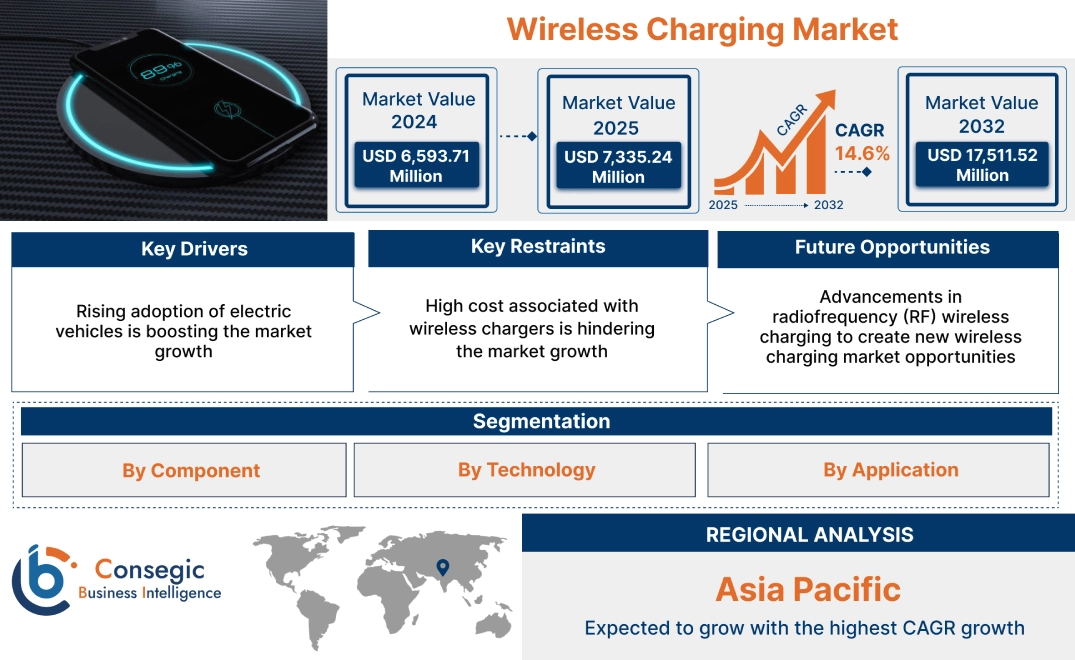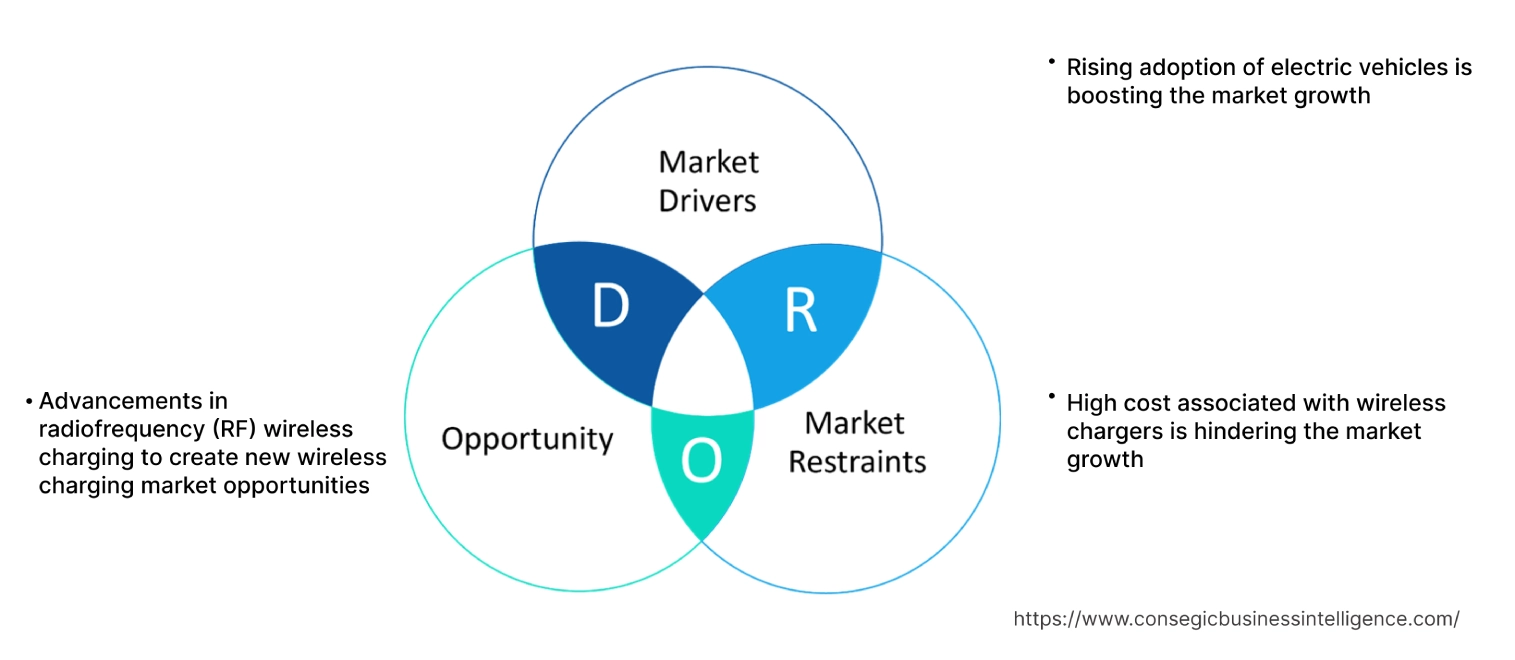- Summary
- Table Of Content
- Methodology
Wireless Charging Market Size:
Wireless Charging Market size is estimated to reach over USD 17,511.52 Million by 2032 from a value of USD 6,593.71 Million in 2024 and is projected to grow by USD 7,335.24 Million in 2025, growing at a CAGR of 14.6% from 2025 to 2032.
Wireless Charging Market Scope & Overview:
Wireless charging, also known as cordless charging,transfers electricity to a device using electromagnetic or radiofrequency technologies, eliminating the need for physical cables.Wireless charging utilizes the principle of electromagnetic induction, where a changing magnetic field induces an electric current in a nearby conductor. A charger contains a coil that generates a magnetic field when electricity flows through it. When a device with a compatible receiver coil is placed on the charger, the magnetic field induces a current in the device's coil, which then powers the device's battery.
Key Drivers:
Rising adoption of electric vehicles is boosting the market growth
The electric vehicles provide several benefits including reduced greenhouse gas emissions, reduced fuel costs, lowered running costs, reduced noise, and zero tailpipe emissions. Moreover, government subsidies, tax benefits and incentives are driving the adoption of electric vehicles across the globe. This, in turn, drives the need for charging infrastructure, leading to growth of cordless charging stations.
- For instance, in July 2024, re:Charge and Capital District Transportation Authority (CDTA) announced the deployment of wireless charging for electric micromobility vehicles in New York and Amsterdam.
Thus, the aforementioned factors are boosting the usage of cordless charging, in turn driving the wireless charging market growth.
Key Restraints:
High cost associated with wireless chargers is hindering the market growth
Wireless charging pads and devices with built-in cordless charging capabilities are more expensive than wired chargers.Cordless charging systems are generally less efficient than wired charging, leading to longer charging times and potentially higher energy consumption due to energy losses during the induction process. This leads to higher energy costs.
Thus, the market analysis shows that the aforementioned factors are restraining the wireless charging market demand.
Future Opportunities :
Advancements in radiofrequency (RF) wireless charging to create new wireless charging market opportunities
Radio frequency cordless charging uses electromagnetic waves to transmit power for charging over longer distances and without precise alignment. A transmitter emits radio waves, and a receiver on the device being charged converts these waves into usable power. RF cordless charging is used in various applications, including charging small IoT devices, powering sensors, and even potentially charging electric vehicles.
- For instance, in September 2024, Infrgy developed a prototype wireless energy transfer system that is able to charge multiple devices at once. The system uses radio frequency to charge devices up to 3 feet without any direct contact.
Thus, the ongoing advancements in radio frequency cordless charging technology are projected to drive wireless charging market opportunities during the forecast period.
Wireless Charging Market Segmental Analysis :
By Component:
Based on the component, the market is segmented into transmitters and receivers.
Trends in the Component:
- Rising demand for transmitters that are able to generate an electromagnetic field of longer range is boosting the wireless charging market size.
- Increasing trend in adoption of receivers to convert the magnetic field energy into electrical energy.
The transmitters segment accounted for the largest revenue share in the wireless charging market share in 2024.
- Cordless charging integrated with a transmitter, often a charging pad or stand, contains a coil that generates an alternating electromagnetic field when connected to a power source.
- For instance, Xnergy launched its Phenoix charger with 1500 W power. The charger consists of transmitter powering unit, transmitter pad, a receiver powering unit, and receiver pad.
- Therefore, the market trends depicts that the wide applications of transmitters are boosting the wireless charging market growth.
The receivers segment is expected to register the fastest CAGR during the forecast period.
- The device being charged has a receiver coil that interacts with the electromagnetic field created by the transmitter.The receiver coil converts the magnetic field back into electrical energy, which then charges the device's battery.
- The receiver does not need any direct contact with the transmitter, but has to be present within the magnetic range of the transmitter.
- For instance, in September 2024, Maxic Technology Inc. launched MT5785, a 100W ultra-fast cordless charging and a reverse transmission of 18W. The receiver is highly integrated SoC cordless charging receiver based on magnetic induction.
- Thus, the wireless charging market analysis depicts that the aforementioned factors are expected to boost the market opportunities during the forecast period.
By Technology:
Based on the technology, the market is segmented into inductive, resonant, radiofrequency, and others.
Trends in the Technology:
- Rising adoption of radiofrequency charging to charge multiple devices at the same time.
- Increasing demand for resonant charging for facilitating long distance charging is boosting the wireless charging market size.
The inductive segment accounted for the largest revenue share of 39.47% in the market in 2024.
- In inductive charging, the charging process relies on the principle of electromagnetic induction, where a changing magnetic field induces an electric current in a nearby conductor.
- A transmitter contains a coil that generates an oscillating magnetic field when AC current flows through it.When a receiver with a compatible coil is placed on or near the pad, the magnetic field induces an AC in the receiver coil.
- The AC current induced in the receiver coil is then converted to direct current (DC) by a rectifier circuit, which is further used to charge the device's battery.
- For instance, in January 2025, InductEv announced it will provide high-power inductive charging for battery-electric cargo handling equipment at the International Transportation Service (ITS). The company’s systems range from 75 kW to 450 kW.
- Therefore, market analysis shows that the wide spread adoption of inductive wireless charging is boosting the wireless charging market trends.
The resonant segment is expected to register the fastest CAGR during the forecast period.
- Resonant cordless charging uses oscillating current in a highly resonant coil to create an electromagnetic field, allowing power transfer over slightly longer distances than inductive charging.
- Resonant chargers use a highly resonant coil and a capacitor to create an oscillating current, generating an electromagnetic field.
- A second coil and capacitor in the device, operating at the same frequency, picks up the power from the electromagnetic field and converts it back into electrical current.
- For instance, Infineon Technologies offers resonant cordless charging solutions. The company offers components for both Class-D and Class-E topologies.
- Thus, the ongoing advancements in resonant charging are expected to boost the wireless charging market demand during the forecast period.
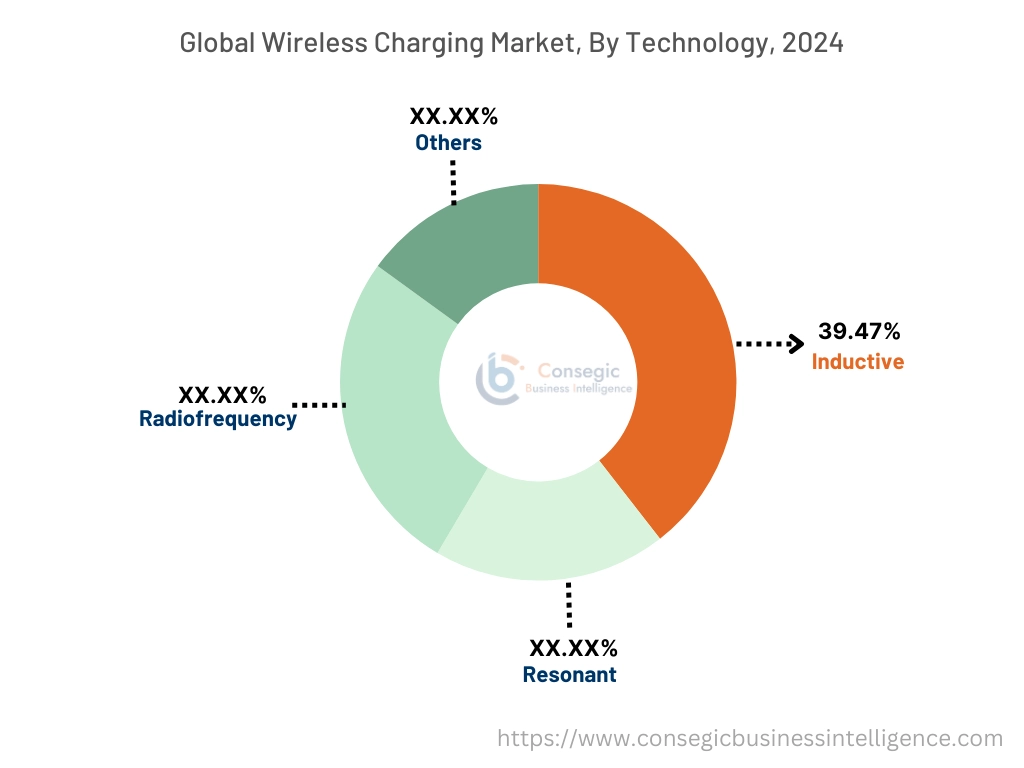
By Application:
Based on the application, the market is segmented into consumer electronics, automotive, industrial, healthcare, and aerospace & defense.
Trends in the Application:
- Rising adoption of cordless charging in healthcare due to reduced infection risks, improved patient comfort, and easier device maintenance.
- Increasing demand in cordless charging in defense industry due to easier maintenance, reduced battery weight and size, and enhanced security.
The consumer electronics segment accounted for the largest revenue share in the wireless charging market share in 2024.
- Wireless charging, using electromagnetic induction, offers convenience and reduces cable clutter, with applications ranging from smartphones, smartwatches, power banks, and other consumer electronics products.
- For instance, in March 2025, HMD unveiled its Amped buds, with its charging case also working as a wireless power bank for smartphones. The case has a capacity of 1,600 mAh battery.
- Therefore, the market analysis shows that the wide spread adoption of cordless charging in consumer electronic sector is driving the wireless charging market trends.
The automotive segment is expected to register the fastest CAGR during the forecast period.
- In automotive sector, the cordless charging offers convenience, eliminates cables, and potentially reduces maintenance, while also paving the way for dynamic charging and autonomous charging capabilities.
- For instance, in June 2024, Satechi launched a wireless car charger. The Qi2 wireless car charger is able to charge a compatible iPhone at up to 15W and is able to mount to a vehicle's vents.
- Thus, the market trends analysis depicts that the rising applications of cordless charging in automotive sector are expected to boost the wireless charging market expansion during the forecast period.
Regional Analysis:
The regions covered are North America, Europe, Asia Pacific, the Middle East and Africa, and Latin America.
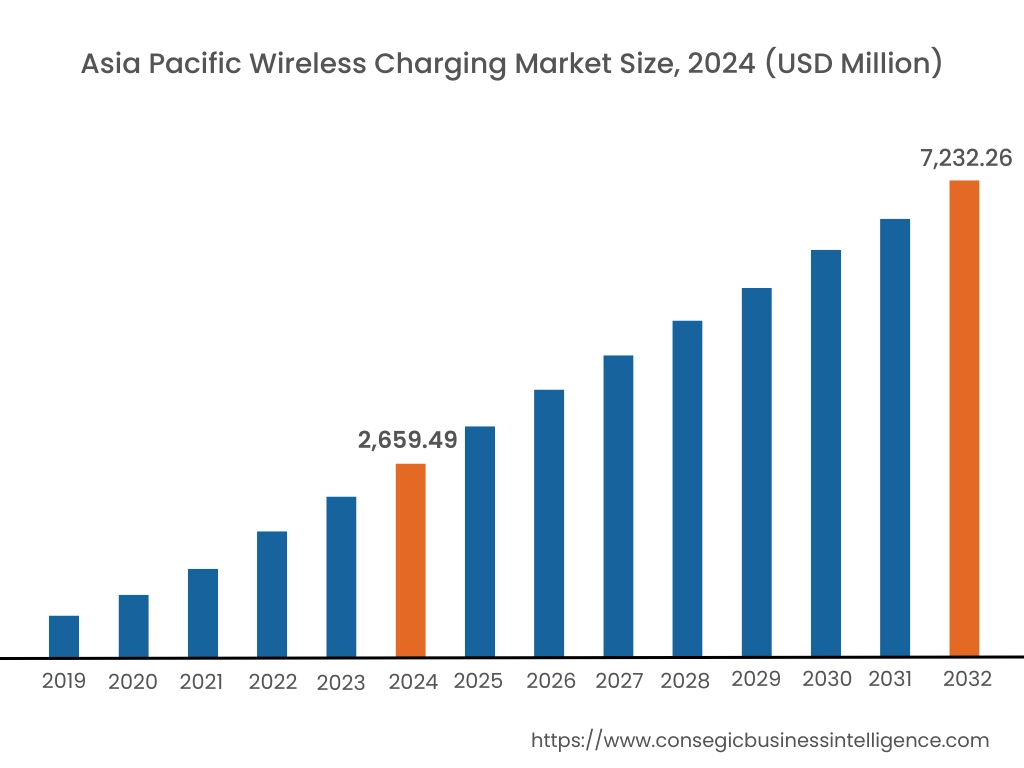
Asia Pacific region was valued at USD 2,659.49 Million in 2024. Moreover, it is projected to grow by USD 2,964.48 Million in 2025 and reach over USD 7,232.26 Million by 2032. Out of this, China accounted for the maximum revenue share of 36.95%. The wireless charging market analysis shows that the market in the region is growing due to rising adoption of electric vehicles in the region. Moreover, the expanding consumer electronics sector in the region is also boosting the usage cordless charging.
- For instance, Xiaomi’s new A Flip smartphone is set to launch in December 2025 in India. The smartphone supports cordless charging with 50W capacity. The above factors are projected to boost the market in Asia-Pacific region during the forecast period.
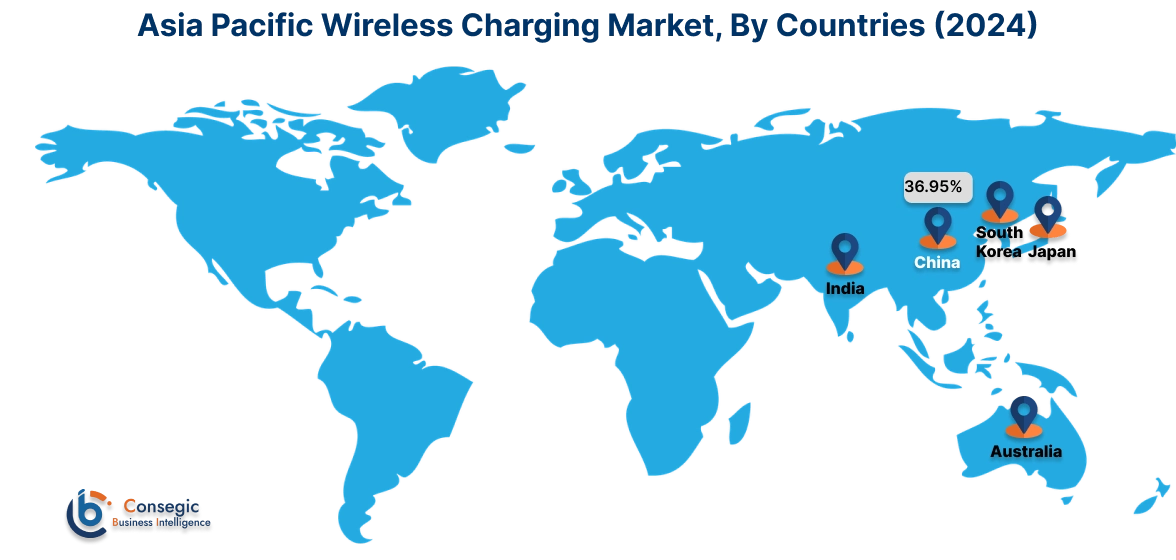
North America is estimated to reach over USD 4,640.55 Million by 2032 from a value of USD 1,737.36 Million in 2024 and is projected to grow by USD 1,933.67 Million in 2025. The market in the region is growing due to technological advancements in the cordless charging, ease of use, convenience, and other benefits. Moreover, the expanding electric vehicle charging infrastructure across the region is boosting the need for cordless charging solutions.
- For instance, Quaze Technologies, in collaboration with L3Harris Technologies Inc., launched tubular cordless charging product. Quaze is a Canada-based technology company while L3Harris Technologies Inc. specailizes in producing innovative solutions in advanced technologies.
The market analysis in European region shows that the market growth is driven due to dynamic charging projects on roads, static charging stations, and rising investments in smart city initiatives. In Latin America, Middle East and Africa the market is showing a steady growth due to rising electric vehicles penetration, demand for convenient outdoor charging solutions, and increasing charging station installations in the region, in turn boosting the wireless charging market expansion.
Top Key Players and Market Share Insights:
The wireless charging industry is highly competitive with major players providing solutions to the national and international markets. Key players are adopting several strategies in research and development (R&D), product innovation, and end-user launches to hold a strong position in the global wireless charging market. Key players in the wireless charging industry include -
- Belkin International, Inc. (US)
- ConvenientPower HK Ltd. (China)
- Energous Corporation (US)
- Fulton Innovation LLC (US)
- Ossia Inc. (US)
- Plugless Power LLC (US)
- Powercast Corporation (US)
- Qualcomm Incorporated (US)
- Renesas Electronics Corporation (Japan)
- Samsung Electronics (South Korea)
- Semtech Corporation
- Sony Corporation (US)
- Texas Instruments (US)
- Witricity Corporation (US)
- ZenS B.V. (Netherlands)
Recent Industry Developments :
Product Launch:
- In February 2025, Advanced Charging Technologies (ACT) in collaboration with Resonant Link, integrated Resonant Link’s advanced wireless charging for ground support equipment (GSE) and material handling equipment (MHE). The solution offers 91% efficiency at 48 V and a power output of 19.2 kW.
Wireless Charging Market Report Insights :
| Report Attributes | Report Details |
| Study Timeline | 2019-2032 |
| Market Size in 2032 | USD 17,511.52 Million |
| CAGR (2025-2032) | 14.6% |
| By Component |
|
| By Technology |
|
| By Application |
|
| By Region |
|
| Key Players |
|
| North America | U.S. Canada Mexico |
| Europe | U.K. Germany France Spain Italy Russia Benelux Rest of Europe |
| APAC | China South Korea Japan India Australia ASEAN Rest of Asia-Pacific |
| Middle East and Africa | GCC Turkey South Africa Rest of MEA |
| LATAM | Brazil Argentina Chile Rest of LATAM |
| Report Coverage |
|
Key Questions Answered in the Report
How big is the wireless charging market? +
Wireless Charging Market size is estimated to reach over USD 17,511.52 Million by 2032 from a value of USD 6,593.71 Million in 2024 and is projected to grow by USD 7,335.24 Million in 2025, growing at a CAGR of 14.6% from 2025 to 2032.
What are the major segments covered in the wireless charging market report? +
The segments covered in the report are component, technology, application, and region.
Which region holds the largest revenue share in 2024 in the wireless charging market? +
Asia Pacific holds the largest revenue share in the wireless charging market in 2024.
Who are the major key players in the wireless charging market? +
The major key players in the market are Belkin International, Inc. (US), ConvenientPower HK Ltd. (China), Energous Corporation (US), Fulton Innovation LLC (US), Ossia Inc. (US), Plugless Power LLC (US), Powercast Corporation (US), Qualcomm Incorporated (US), Renesas Electronics Corporation (Japan), Samsung Electronics (South Korea), Semtech Corporation, Sony Corporation (US), Texas Instruments (US), Witricity Corporation (US), and ZenS B.V. (Netherlands).
